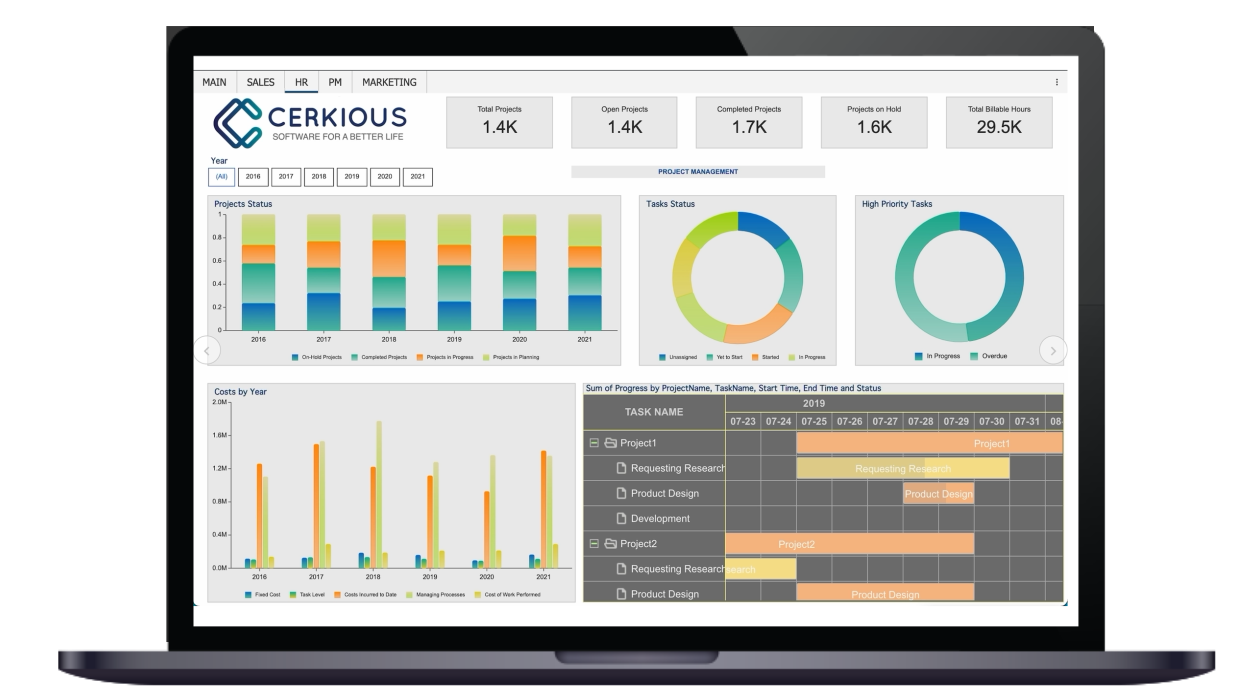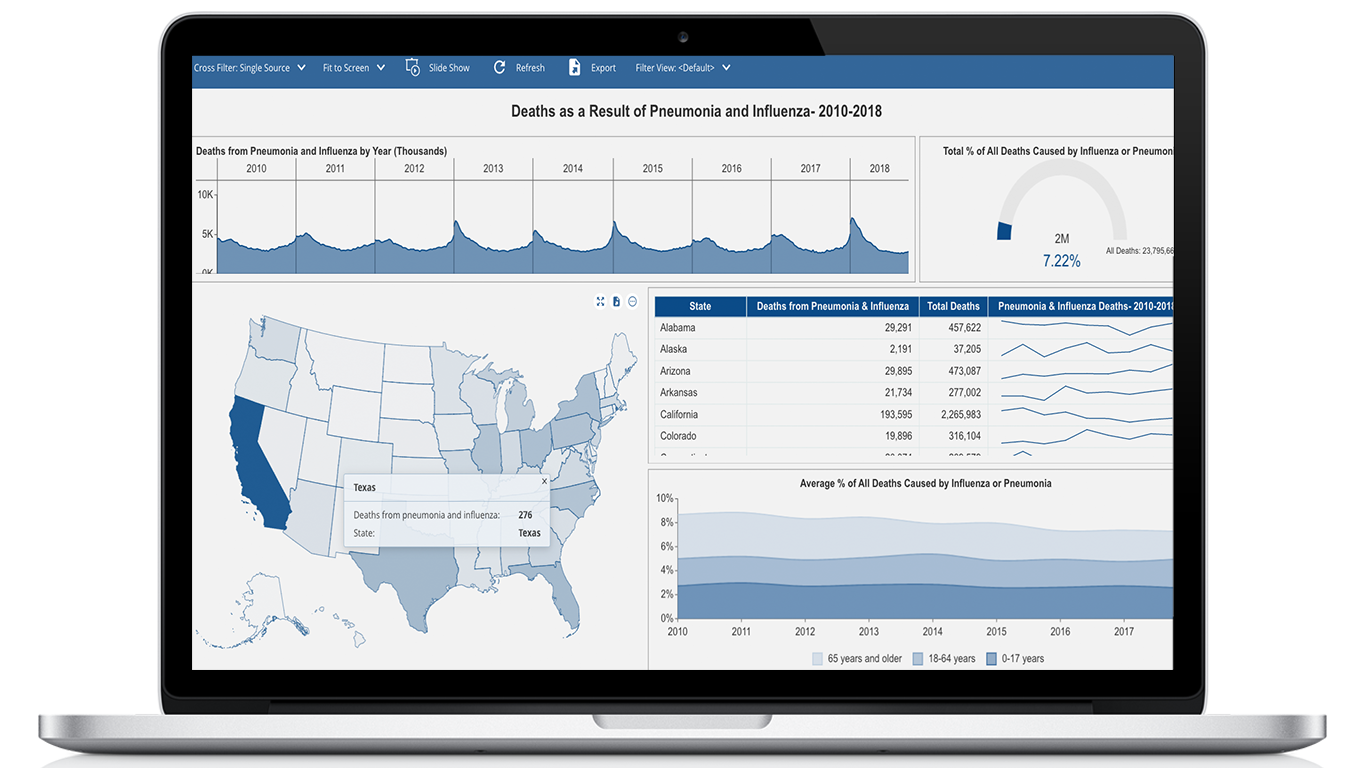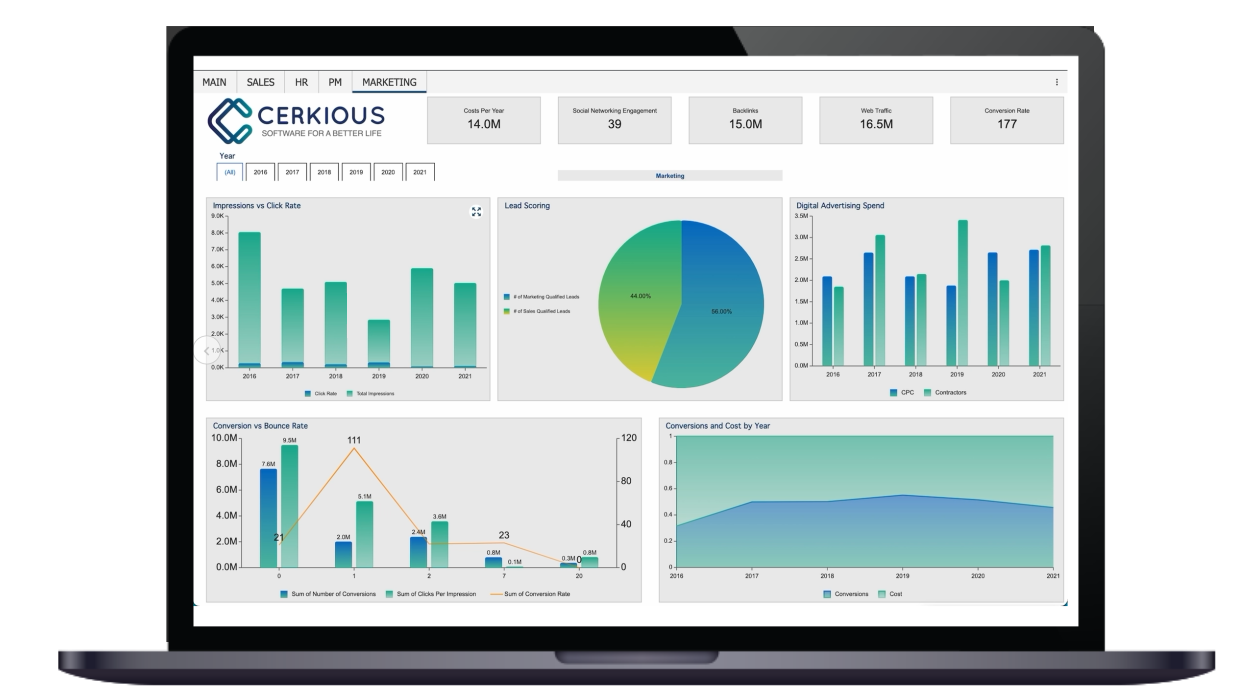The pharmaceutical industry is highly information-intensive, from compliance to manufacturing and quality control, to name just a few areas. Making business intelligence (BI) a part of the workflow and decision-making process rather than just an afterthought is critical to placing BI in the hands of users at the right time. Embedding BI in the decision-making process allows companies to see relevant BI information within their application instead of having to deal with other applications or tabs on a browser.
While any BI software must support an organization’s business needs, embedded BI must support those needs on a timely basis from within industrial applications and workflows. In other words, embedded BI applications are tailored to a given industry and workflow.
In this article, we’ll go over the top features of a pharmaceutical BI solution and demonstrate how various pharmaceutical processes can benefit from using embedded BI. Those processes include:
Compliance
The pharmaceutical industry has had to deal with constantly changing and increasing compliance issues. Companies must comply with the regulations of every country where they conduct business. Each country has its standards, and those standards change. A company may have numerous systems and workflows in various countries that must satisfy different compliance reporting requirements. These may be driven by manual or automated processes. When regulatory or reporting requirements change, so must the systems that collect and monitor the data.
The earlier a company can detect variance from compliance requirements, the more likely it is to implement remediation to meet these requirements. Let’s take the job of generating compliance reports as an example. This job involves collecting and monitoring results from different jurisdictions, such as the Food and Drug Administration (FDA), European Medicines Agency (EMA), Department of Health and Human Services (DHHS), Veterans Affairs (VA), and others. Investigations and financial and criminal judgments have made monitoring and remediation more of a priority. Embedding BI functionality in this process can eliminate errors and make responsible knowledge workers more effective.
This situation has become a higher-stakes proposition because recent investigations and aggressive prosecutions have resulted in significant financial judgments and criminal convictions. (This website provides a description of some of the largest pharmaceutical lawsuits.)
This trend is driving a powerful reaction among companies to implement robust enterprise-wide compliance management programs designed to reduce risk, enhance management controls, and ensure compliance. Using embedded BI to incorporate data from these processes into the monitoring workflows can prevent violations.
Efficiency
Being the fastest to bring new products to market (the first mover’s advantage) is standard practice in the pharmaceutical industry. But speed should not be confused with efficiency. Even if a company is not the first mover, its ability to bring its products to market is essential. The time it takes to complete the various steps and certifications necessary to develop a product must be considered.
A pharmaceutical company has any number of simultaneous product development processes underway at any given time. If the operations of each team are standard, it begs the question, “How efficient is the standard process?” Analyzing the efficiency of standardization is an area where embedded BI can help. It can bring together information from disparate teams to analyze the efficiency of their processes. Process dependencies sometimes cause one group to slow down because another team needs to finish an operation on the critical path. Time lost at these bottlenecks slows the entire process, lengthening the time to market.
Another question that embedding BI into project management processes can help answer relates to best practices. If the processes in teams or departments differ, are there any that are noticeably better than others? In this case, BI closely aligns with seeking best practices. The first step is to identify potential best practices. Then you must ask, “Is there anything unique to the situation where they are occurring, or could they be applied to other areas?” For example, if the incubation of bacteria is part of the process, do the incubation methods differ from product to product? Is one technique, such as using a higher temperature, more efficient than another? Is using a higher temperature acceptable to other processes, or will it kill the bacteria grown in those processes? Embedding BI allows you to examine the processes that affect time to market and identify methods to improve processes in the organization.
Marketing
In many ways, the pharmaceutical industry is like any other industry when it comes to marketing and research on marketing effectiveness. BI takes data from marketing, media advertising, packaging, and focus groups, and evaluates their effectiveness. One channel may be more effective than others for obtaining customers. Also, A/B testing can determine which marketing messages and techniques are more effective than others.
One significant difference in pharmaceutical marketing is that it has two audiences that it approaches differently. One audience is the consumer. Here, specific mass marketing measures apply, and BI can help make decisions.
The pharmaceutical industry directs the most significant proportion of marketing spending to pharmaceutical providers. This spending includes the pharmaceutical representatives visiting providers regularly to introduce them to their company’s products. These representatives must understand their product and how it treats patients — while remaining within compliance guidelines.
Embedding BI in their mobile platforms can help representatives to understand which techniques are working and with what providers. By pairing marketing information with sales and analyzing the results, organizations can understand the why behind the sales figures. This can also help field representatives to be more effective. Things like understanding the average number of visits to a provider’s office to obtain a meeting can inform the training of new representatives. Knowing that it takes five trips to get a meeting would limit a new representative's frustration and increase their retention and effectiveness.
With field representatives, the ability to embed BI functionality into applications they use to perform their job also ensures effectiveness. For example, consider information about the demographics and economics of the provider’s location. If you embed this information using a dashboard into the representative’s call tracking application, they can easily access it as part of their workflow and plan a visiting strategy.
Financial Analysis
As with virtually every industry, analyzing costs and income to deliver shareholder value is critical. Pharmaceuticals have a large front-end outlay to bring a drug to market, and these costs include research and development (R&D), clinical trials, and compliance activities. To be successful, a company must convert these expenses to income over the life of the drug, and they must also pay for unsuccessful R&D efforts. This calculation must consider the present and future value of money.
BI ensures the ability to take information from the company’s financial picture and analyze it to answer important questions like, “How did last month’s R&D overruns affect our timeline for making a particular drug line profitable?” Analysts can use embedded BI to do this without leaving the financial application. The ability to present financial data in visualizations allows decision makers to make data actionable and perform course corrections in a timelier manner.
Operational Analysis
The main areas of a typical pharmaceutical operation include:
· Raw material storage
· Treatment
· Production units
· Packing
· Shipment
A given product may pass through any number of production units, and production units may serve multiple product lines.
Switching product lines within a production facility may include cleaning to avoid cross-contamination. In addition, you’ll need to consider if recertification is necessary to ensure safety. Embedded BI can organize and analyze data from multiple databases to help you plan downtime and analyze the cost of lost production over time compared to the cost of building and maintaining separate units for each product or set of products.
With raw materials, purchasing decisions mean incorporating volume discounts, storage costs, and expiring raw materials to determine the purchase amount and order interval. This process involves obtaining and analyzing data from multiple sources, some of which may reside outside the company.
Focusing on each area contributing to taking the product from raw materials to shipping it to the customer can reveal potential inefficiencies in the production process. BI enables you to integrate data from multiple sources without manual intervention and impart it to the relevant decision makers.
Inventory Monitoring
The number of channels available for distribution makes inventory in the pharmaceutical industry more complicated. BI allows you to combine all channels into a single inventory report to provide an accurate picture of the inventory.
One channel is direct to the consumer. In the direct channel, the company puts its products directly into the consumers’ hands, usually through mail orders.
Another channel is the giant pharmaceutical distribution houses. Here, distributors obtain the inventory from the producer and sell it to organizations, such as hospitals or other large health care providers or retailers. In some cases, wholesalers may act as distributors to their own stores.
Pharmaceutical inventory management must consider not only the inventory in their warehouse but also the hands of downstream partners. For example, a company’s view of inventory on hand must include the large amounts of inventory in the hands of distributors. Understanding the consumption rate of distributors’ inventory changes the view of the amount of inventory on hand, affecting manufacturing plans. This problem is also applicable to other non-direct channels.
With multiple channels and participants in each channel, monitoring inventory becomes more complex than simply counting the inventory in a warehouse. Channel partners may agree to provide the company with inventory and consumption reports. However, these companies must still assemble the information into a single actionable view of inventory to assist in planning and avoid shortages or expired inventory. Embedding BI into existing processes allows for data integration, analysis, and visualization from multiple providers, which removes large amounts of manual manipulation, saves time, and enables timely decision making.
Quality
As with anything related to health, quality is critical in the pharmaceutical industry, and quality failures can severely affect a company’s brand equity. A BI system for a pharmaceutical company must allow the company to focus on numerous target areas in multiple workflows. These areas include production, facilities and equipment, laboratory controls, packaging and labeling, and materials. It must decompose major areas into processes and quality measures to establish quality standards and a continuous measurement program.
The area of adverse patient reactions is outside the company’s walls, but companies must consider it. Treating adverse drug reactions can cost 30.1 billion dollars annually, making it a huge problem. While pharmaceutical companies conduct clinical trials, they can't test every possible negative reaction. This is one area where BI and access to data outside the pharmaceutical company can help. Employing BI to identify adverse effects and mitigate their cause early can avoid drug recalls and prevent reputation loss.
Conclusion
BI allows you to integrate, analyze, visualize, and take action to improve the performance of a pharmaceutical organization. Many areas mentioned include a company’s ability to partner with the organizations that distribute and consume its products. Because of the nature of the pharmaceutical industry, this collaboration is critical to creating an accurate end-to-end picture of the business.
Wyn Enterprise from GrapeCity provides not only ways to analyze and visualize your data but also ways to embed BI into your daily workflows, making them even more actionable. To learn more about Wyn Enterprise, click here.































